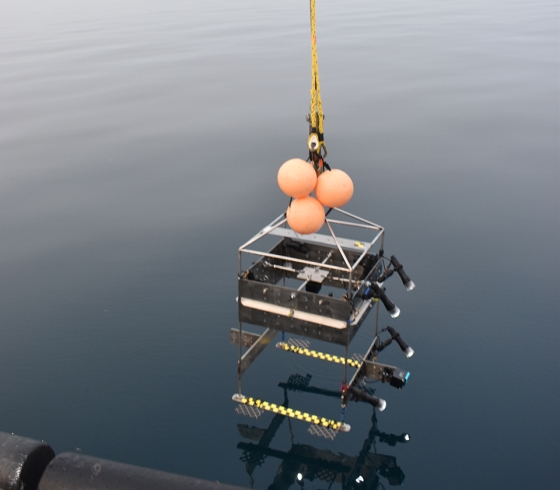For the third time since 2012, Buffalo State College’s Great Lakes Center has been awarded a grant through the United States Environmental Protection Agency (EPA) to continue monitoring benthic invertebrates in the Great Lakes.
The entire grant of $6.7 million was awarded by the EPA Great Lakes National Program Office to Cornell University and Buffalo State. James Watkins, associate director of the Cornell Biological Field Station, is the principal investigator of the project. Cornells team, working in collaboration with the GLC, will monitor zooplankton and mysid crustaceans.

Benthic Imaging System is deployed to collect video from all depths in Lake Michigan.
Benthic invertebrates are organisms that live on the bottom of the lakes and are commonly used as indicators of the biological condition of water bodies. Lower food web invertebrates in the plankton and benthos represent important intermediaries between primary producers and fish, and changes in their diversity and biomass provide insight into ecosystem dynamics and health of the Great Lakes.
The grant is funded through the Great Lakes Restoration Initiative, and Buffalo State will receive more than $3 million, which will fund research through the beginning of 2028. Alexander Y. Karatayev, director of the GLC, Lyubov E. Burlakova, senior research scientist, and Allison R. Hrycik, research scientist with the GLC, procured the grant for Buffalo State. The funding is part of a larger effort to restore and protect the Great Lakes.
The grant will benefit Buffalo State students by funding positions for graduate student researchers and undergraduate technicians in the GLC. It will also include independent research opportunities.
“We are very happy to continue our participation in the monitoring of one of the largest systems of surface freshwater on earth,” Burlakova said. “The U.S. EPA Great Lakes National Program Office water quality survey constitutes the longest-running, most extensive monitoring of water quality and the lower trophic level biota of the Laurentian Great Lakes. This monitoring program has been instrumental in tracking shifts in the water quality and lower food web over the past several decades.”
The project will allow researchers at the GLC to continue the work they’ve been doing in the Great Lakes in monitoring changes in benthic communities, Burlakova said.
EPA Research Vessel Lake Guardian
“Within this project, we will combine the annual sampling at 57 long-term monitoring stations with spatially broader lake-specific benthic surveys coincident with the Cooperative Science and Monitoring Initiative five-year rotation of lakes,” she said. “We will continue to compile data of historical lake-wide benthic surveys on the Great Lakes to reveal long-term trends in benthic communities, as we already completed for lakes Michigan, Ontario, and Erie. In addition, we will carry out several applied research projects and will apply emerging modeling techniques to better understand the observed changes in biological communities.”
As with previous projects, researchers expect to produce multiple publications and presentations at scientific meetings, as well as providing research opportunities for graduate and undergraduate students in both institutions.
The EPA awarded these funds to Buffalo State and Cornell to conduct monitoring and research activities in support of EPA’s Great Lakes Biology Monitoring Program, which was initiated in 1983 to assess the health of the Great Lakes. This work will include continued monitoring of the status of the food web in each of the Great Lakes, allowing researchers to better understand how the ecosystem has responded to stressors such as changing nutrient conditions, invasive species, and a warming climate. Data and information from this program provide vital information for Great Lakes water quality and fisheries management efforts.
Top photo: Research scientists with the GLC, procured the grant for Buffalo State. The funding is part of a larger effort to restore and protect the Great Lakes.

